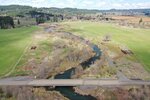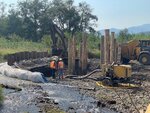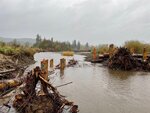

.jpeg)

More than 140 local fish and flood projects have been completed across the Chehalis River Basin, coordinated and funded through the Office of Chehalis Basin (OCB).
The OCB board is composed of local officials as well as tribal and environmental representatives.
These projects are done in cooperation with the Chehalis River Basin Flood Authority, local governments, tribes and the Aquatic Species Restoration team. Together, these projects are part of the Chehalis Basin Strategy to restore aquatic species and to reduce flood damage for families and communities.
This article is part of an ongoing series highlighting projects that have been completed in the basin. The Chronicle has partnered with the Office of Chehalis Basin for this series. Read previous installments at chronline.com.
Project summary
Stillman Creek, a tributary to the South Fork Chehalis River, is a salmon-bearing creek in Lewis County. In partnership with four private landowners, the Washington Department of Fish and Wildlife (WDFW), Capitol Land Trust and Lewis Conservation District restored 2 miles of habitat and improved more than 45 acres to benefit coho and Chinook salmon, steelhead trout, lamprey and other aquatic species.
This is the largest project completed to date as part of the Chehalis Basin Strategy’s Aquatic Species Restoration Plan.
The problem
Stillman Creek was already in trouble, suffering from a combination of land degradation and climate change. This led to the loss of instream habitat and riparian vegetation, bank erosion and increasing summer water temperatures that are harmful to fish.
The historic 2007 flooding that hit the Chehalis Basin pushed Stillman Creek into even worse conditions, filling the creek bed with debris and sediment and substantially moving the channel to the east.
“I’ve lived here my whole life,” said Nikki Atkins, watershed liaison for the Lewis Conservation District. “Landowners in the area care deeply about their environment and they care deeply about their community. They want their grandkids, their kids and their neighbors to have the same experience they had growing up. They want to do what they can to protect it into the future.”
The project
WDFW, Capitol Land Trust, Lewis Conservation District and private landowners worked from 2018 to 2022 to develop and design the restoration and protection actions to help the stream recover. The Office of Chehalis Basin provided about $8.5 million to design and complete the Stillman Creek pilot project. That included providing $398,000 to Capitol Land Trust to acquire and permanently protect 38 acres along the creek.
Project construction started during the summer of 2022 and was completed in the summer of 2023. The overall goal of the project was to restore natural river processes by reintroducing large wood, excavating side and off channel habitats, and enhancing riparian areas by planting native vegetation. These actions are designed to create new habitat for aquatic life, provide refuge during higher winter flows, reconnect Stillman Creek with its floodplain, and slow down and shift water movement in the channel to help reduce erosion and improve habitat for fish and other aquatic species. The work also includes installing native tree and shrub plantings along the river bank and protecting existing riparian vegetation to shade the creek, keeping water temperatures cooler. In addition to other native aquatic species in this stream, this project specifically benefits coho, steelhead, fall Chinook and spring Chinook.
“What we’re trying to do is create roughness in the floodplain so when it floods, there is something to slow the water down so it’s not like a firehouse,” Atkins said. “We are hoping that helps with bank erosion and reduces the firehouse effect that kills Chinook salmon.”
Celina Abercrombie, Chehalis Basin Strategy manager for WDFW, said the work was aimed at helping fish along with farming and forestry in the area.
“I feel very fortunate to have had this opportunity to work with some amazing landowners to restore and protect important habitat on their property for fish and other species, and to demonstrate what is possible,” Abercrombie said. “WDFW is grateful for the partnerships this project created with landowners, the Lewis Conservation District and Capitol Land Trust who were instrumental in bringing the project together.”
The impact
The vast majority of the work for the Stillman Creek Restoration Project has been completed, and final native vegetation plantings in the riparian areas will take place this winter.
Overall, this project included:
• Two miles of river habitat restoration
• Four partnerships with landowners
• 38 acres of habitat protected and restored
• 110-plus large wood structures installed
• 40-plus acres treated for invasive plants
• 45 acres of plantings of more than 45,000 native trees and shrubs
Together, these improvements will create new in-water habitats, reconnect Stillman Creek with its floodplain, and slow down and shift water movement in the channel to help reduce erosion and improve habitat for aquatic life — especially coho salmon, steelhead trout, and fall and spring Chinook salmon.
“This area is very important to me because it’s the land I grew up on. I just felt well, if it’s going to help the salmon we might as well do it,” said Elizabeth Senderak, voluntary landowner and project participant in Boistfort, Washington. “I would say (to fellow landowners), give it a chance, see what works for you, and it’s definitely going to be a plus for the environment.”
For more information about the project, visit https://tinyurl.com/y25d3ffz.
About the Chehalis Basin Strategy
The Chehalis Basin Strategy is a network of partners and projects dedicated to protecting communities from flood damage, restoring critical habitat for aquatic life and ensuring the Chehalis Basin is safe and prosperous for people, fish, and wildlife for generations to come.
The Strategy, through the Office of Chehalis Basin, has invested nearly $152 million in on-the-ground flood preparation, flood damage reduction and aquatic species restoration, and has completed more than 140 projects, with dozens more underway.
The Strategy is led by a group of representatives with diverse interests and perspectives called the Chehalis Basin Board and is administered and funded by the Washington Department of Ecology’s Office of Chehalis Basin. It depends on its many partners across the Chehalis Basin and the state to inform the path forward and take projects from ideas to reality.